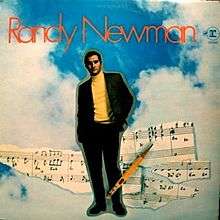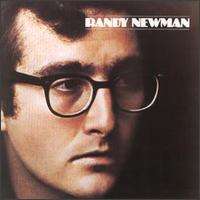Randy Newman (album)
Randy Newman is the eponymous debut studio album by American singer-songwriter Randy Newman, released in 1968 by Reprise Records. Unlike his later albums, which featured Newman and his piano backed by guitar, bass guitar and drums, Randy Newman was highly orchestral and aimed to blend the orchestra with Newman's voice and piano.
| Randy Newman | ||||
|---|---|---|---|---|
 Original LP cover | ||||
| Studio album by | ||||
| Released | June 1968 | |||
| Recorded | 1968 | |||
| Length | 27:24 | |||
| Label | Reprise | |||
| Producer | ||||
| Randy Newman chronology | ||||
| ||||
| Singles from Spring | ||||
| ||||
| Revised cover | ||||
 | ||||
Randy Newman never dented the Billboard Top 200 and was not received as well by critics as Newman's acclaimed 1970s albums 12 Songs, Sail Away and Good Old Boys; indeed, according to Ken Tucker, the album sold so poorly that Warner offered buyers the opportunity to trade the album for another in the company's catalog.[1]Randy Newman was out of print for over 15 years until it was re-released on CD in 1995. It was remastered by Lee Herschberg.
The album is sometimes referred to as Randy Newman Creates Something New Under The Sun, which was written on the reverse of the album sleeve.[2][3] In 2017, Randy Newman was ranked the 97th greatest album of the 1960s by Pitchfork.[4]
Details
Newman later commented on the lack of influence from rock and roll on the album.
"It's like I'd never heard The Rolling Stones. I thought you could move things along just with the orchestra, that it was somehow cheating to use drums. What Van Dyke and I, and Harry Nilsson to some degree, were doing, it was like a branch of homo sapiens that didn't become homo sapiens. Homo erectus," he said.[5]
Newman said in 2017, that he signed away the publishing rights on his first album, doesn't see any money from people doing covers of those songs and advised people getting into the business to never sign away their publishing.[6]
Previous versions of songs on this album
As with many of Newman's early albums, several Newman-penned songs had been previously recorded by other artists.
- "I Think It's Going to Rain Today", was originally recorded and released by Julius LaRosa in 1966. It had also been covered in 1966/67 by Judy Collins, Eric Burdon, and others.
- "Living Without You" was issued as a single (under the title "So Hard Living Without You") by Keith Shields in February 1967. "Living Without You" was also featured on the "Uncle Charlie & His Dog Teddy" album by The Nitty Gritty Dirt Band.
- "Love Story" was released as a single by The Brothers in August 1967. It was also recorded by Peggy Lee (1970 single), Harry Nilson, on Nilsson Sings Newman, Liza Minnelli, on Come Saturday Morning and on a 1971 duet album by Glen Campbell and Anne Murray.
- "So Long Dad" was released as a single by Manfred Mann in September 1967.
- The Alan Price Set issued recordings of "Living Without You", "Bet No One Ever Hurt This Bad" (as "No One Ever Hurt So Bad") and "So Long Dad" on their 1967 album A Price On His Head.
Singles
"I Think It's Going to Rain Today" b/w "The Beehive State" was issued as a single on Reprise 0284. Reprise also issued this single on a promotional 10" vinyl 78 rpm record as the first (and only) release under their proposed "Reprise Speed Series" of 78 RPM releases (the series was discontinued by Reprise due to a lack of interest and sales a few months after this release).[7]
Reception
Rolling Stone noted, "the mood of a bitter longing for affection that characterizes the album.
Denny Cordell has called Randy “the foremost practitioner of suburban blues,” and certainly “Love Story” is the blues of Middle America. The song marks out a simple pattern of life: boy meets girl, gets married, lives in suburbia, has children, dies. Randy moves in on The Dream in an uncommon way: “When our kids are grown/They’ll send us away to a little home in Florida/ We’ll play checkers all day/Till we pass away.”"[8]
Legacy
Critic Ellen Willis feels that the songs on the album, "show an intimate familiarity with, and an affection for, all the nuances of American life - the setting and characters, the family relationships, the romantic fantasies, the euphemisms - as well as an unsparing awareness of our oppression of old people, fat people, and other nonmainstream types."[9]
William Ruhlmann in an AllMusic retrospective review feels that Newman's lyrics are "intent upon taking clichés and using them to satirize social conventions, a popular parlor game in the late '60s." Overall he considers the album "an audacious first album by a major, if extremely quirky, talent."[10]
In 2000 it was voted number 716 in Colin Larkin's All Time Top 1000 Albums.[11]
Track listing
All songs written and arranged by Randy Newman.
- "Love Story (You and Me)" – 3:20
- "Bet No One Ever Hurt This Bad" – 2:00
- "Living Without You" – 2:25
- "So Long Dad" – 2:02
- "I Think He's Hiding" – 3:04
- "Linda" – 2:27
- "Laughing Boy" – 1:55
- "Cowboy" – 2:36
- "The Beehive State" – 1:50
- "I Think It's Going to Rain Today" – 2:55
- "Davy the Fat Boy" – 2:50
Personnel
- Randy Newman – vocals, piano
- Anthony Terran – trumpet
- Herb Ellis – guitar
- Jim Horn – saxophone
- Plas Johnson – saxophone
- Larry Knechtel – guitar, bass guitar, keyboards
- Carol Kaye – bass guitar
- Al Casey – guitar
- Milt Bernhart – trombone
- Mike Deasy – guitar
- Ron Elliott – guitar
- Lyle Ritz – bass guitar
- Jim Gordon – drums
- Tommy Morgan – harmonica
- Ray Kelley – cello
- Ted Nash – saxophone
- Don Bagley – bass guitar
- James Burton – guitar
- Israel Baker – violin
- Arnold Belnick – violin
- Harold Bemko – cello
- Harry Bluestone – violin
- Samuel Boghossian – viola
- Gene Cipriano – saxophone
- Gary Coleman – percussion (including mallets)
- Nick DeCaro – piano, accordion
- Frank DeCaro – guitar
- James A. Decker – French horn
- David Duke – French horn
- Carl Fortina – accordion
- Frederick Seykora – cello
- James Getzoff – flute
- Joe Gibbons – guitar
- William Green – saxophone
- Dick Hyde – trombone
- Armand Karpoff – cello
- Louis Kievman – viola
- William Kurash – violin
- Michael Lang – piano
- Don Lanier – guitar
- Gary LeVant – harmonica
- Tommy LiPuma – engineer
- Leonard Malarsky – violin
- Lew McCreary – trombone
- Jay Migliori – saxophone
- Sid Miller – saxophone
- Ollie Mitchell – trumpet
- Louis Morell – guitar
- Richard Perissi – French horn
- William R. Perkins – saxophone
- Jerome Reisler – violin
- Victor Sazer – cello
- Ralph Schaeffer – violin
- Wilbur Schwartz – saxophone
- Leonard Selic – viola
- Sid Sharp – violin
- Tommy Tedesco – guitar
- Sal Valentino – guitar, vocals
- Tibor Zelig – violin
- Hubert Anderson – percussion (including mallets)
- Joseph DiFiore – viola
- William Hinshaw – French horn
- Thomas Scott – saxophone
- Harold Ayties – viola
- Jesse Emrlich – cello
- Elizabeth Ershoff – harp
- David Filerman – cello
- Gene Garf – piano, organ
- Jan Hlinka – viola
- Norman Jeffreis – drums
- Gordon Pope – saxophone
- James Rowles – piano
- Joseph Tullio – cello
- William Weiss – violin
- Robert Knight – trombone
- Technical
- Lee Herschberg – engineer, supervisor
- Ed Thrasher – artwork
- Guy Webster – cover photography
References
- Rolling Stone History of Rock & Roll 1986, p. 475.
- Kevin Courrier, Randy Newman's American Dreams, ECW Press, 2005, p.119
- William Ruhlmann, Review of Randy Newman, Allmusic.com. Retrieved 21 November 2015
- "The 200 Best Albums of the 1960s". Pitchfork. August 22, 2017.
- Keith Phipps (8 October 2003). "Randy Newman". A.V. Club.
- http://www.wtfpod.com/podcast/episode-831-randy-newman
- Billboard Magazine, November 23, 1968, "Reprise KO's 78's"
- Bruce Grimes (16 April 1970). "Randy Newman: 12 Songs". Rolling Stone.
- Ellen Willis (2011). Out of the Vinyl Deeps. University of Minnesota Press. pp. 105. ISBN 978-0-8166-7283-7.
- William Ruhlmann. "Randy Newman". allmusic.
- Colin Larkin (2000). All Time Top 1000 Albums (3rd ed.). Virgin Books. p. 229. ISBN 0-7535-0493-6.